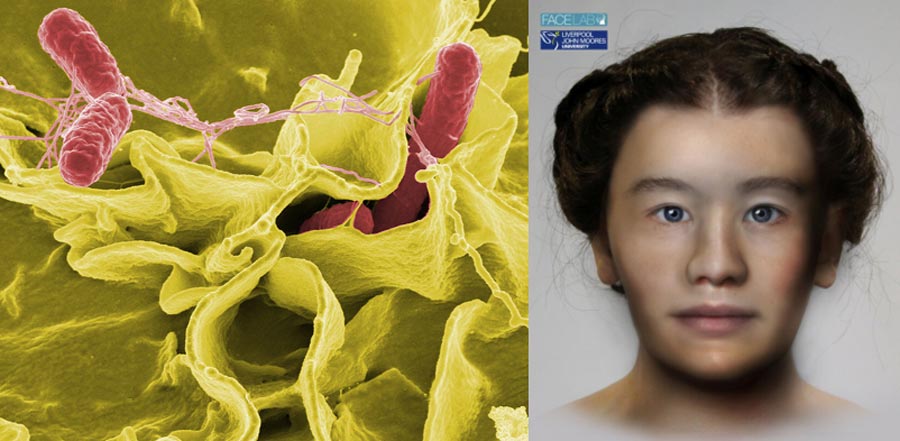Ancient Norse Teeth Plaque Helps Explain Pandemics
A team of Norwegian scientists have been tracking the evolution of diseases in medieval bodies. Not only have they added to the understanding of how diseases become pandemics, but they’ve revealed new insights into the long-term effects of ‘elite breeding’ patterns.
Ready for a mouthful? Salmonella enterica serovar Paratyphi C causes what’s known as ‘enteric (paratyphoid) fever’ in humans. This disease can lead to asymptomatic blood infections and gastrointestinal or urinary tract infection, and at its worst it can cause septicaemia, from which there’s little chance of recovering.
A new study has looked at samples of Paratyphi C genome (Ragna) recovered from a 1200-year-old skeleton (SK152) of a young woman discovered in Trondheim, in northern Norway. While Ragna was very rare in Europe and North America at this time, the new findings suggest that Paratyphi C enteric fever may once have had ‘a wide-ranging impact on human societies.’
- 1,000-year-old Viking Boat Burial Discovered Under Market Square in Norway
- Norwegian Archaeologists Have Found the Shrine of a Miracle-Making Viking King

A) Excavation site (Folkebibilotekstomten, 1973–1985) of the church cemetery of St. Olav in Trondheim, Norway. The burial location of SK152 (red circle) belongs to a building phase that has been dated archaeologically to 1200 CE (range 1175–1225). B) Entire skeleton (top) and femoral long bone plus two teeth from which Salmonella DNA was extracted (bottom). (Cell/Current Biology)
Studying Old Pandemics, To Avoid New Ones
Dr Axel Christophersen is a professor of historical archaeology at the NTNU University Museum in Trondheim, who was involved in the new MedHeal Project study. DNA containing Paratyphi C was recovered between the ancient woman’s teeth and bones. This would have caused a Salmonella infection in her intestinal tract and the researcher says the woman probably died of enteric fever.

Color-enhanced scanning electron micrograph showing Salmonella Typhimurium (red) invading cultured human cells. (Public Domain)
Professor Christophersen says by ‘digging deep’ the team of researchers have figured out how diseases changed the way medieval populations interacted and behaved. Understanding this, says the scientist, might help diseaseologists better understand how SARS-CoV-2 and other pandemics occur and spread. In turn, governments will be better informed as to how to respond to future pandemics.
Tracking Ancient Pathogen Leaps
Tom Gilbert is an evolutionary biologist at the University of Copenhagen who is also a professor at the NTNU University Museum, and he served as the lead researcher on the MedHeal research team. Dr Gilbert is most interested in what ancient DNA gathered from between teeth can tell science about ancient and modern pathogens.
Dr Gilbert found it of great interest to discover Salmonella in the plaque samples, for it’s a pathogen that was until now not believed to have existed in Europe at that early time. Studying old pathogens enabled the researchers to figure out when the first transmissions of the disease occurred, and the circumstances surrounding the pathogen leap. Knowing how ancient pathogens leaped from person to person helps with monitoring the transferal of modern diseases, according to the new study.
1100 Years Old, But He Looks Like A Modern Norseman
The MedHeal project allowed Professor Gilbert and his colleagues to study the DNA in several Trondheim skeletons, so as to determine their places of origin. The team identified an 1100-year-old man in Trondheim who looks ‘exceptionally like a modern Icelander,’ and it is suggested that he was a ‘high-status’ individual, for several reasons.

Modern Icelandic men, in traditional dress. (CC BY-SA 3.0)
The researchers applied isotope analysis to determine that the individual had indeed come from Iceland. Furthermore, his particular genome is most closely related to those of modern Icelandic genomes, wrote the team. To account for this the scientists suggested that because of the high levels of conflict in Iceland in the 1100s the person might have come to Trondheim from Iceland to ‘negotiate with royals who would have been in the city during the period’.
A Desperate Islander Looking For Royal Alliances?
‘High-born means more children,’ said Gilbert. His reasoning here is that better heeled people, ‘high status,’ breed more and have more offspring. This being the case, when someone in a community seeded lots of children the whole community would, over several generations, all begin to look like them. The result of this is that the modern population of Iceland and Norway look even more like their high-class ancestors, because there's more of their DNA in the current population.
Discovering that this particular Icelander looked much more like a modern Icelander than other Icelanders from the 1100s, reinforces Dr Gilbert’s notion that the man was a societal elite, and that he had lots of children. He summarised all this by saying the ‘guys who had the wealth had all the children.’ This is why it is expected that during the 1100s civil strife in Iceland the richest folk travelled to Trondheim to rally support from the Norwegian king.
Top image: Researchers from Norway, France, Austria and England were able to use information from SK152 to reconstruct what she might have looked like. Source: Stian Suppersberger Hamre/FaceLab
By Ashley Cowie




















Comments
“‘High-born means more children,’ said Gilbert.”
In my world it is the lower socioeconomic people that have more children. If this is the case then it turns this article (research) a little on its head.
Pete, affected not effected and eunuchs not eunichs.